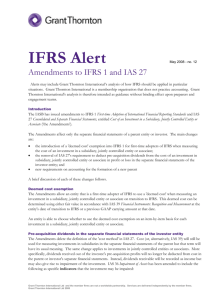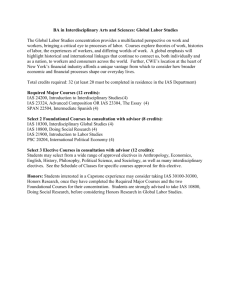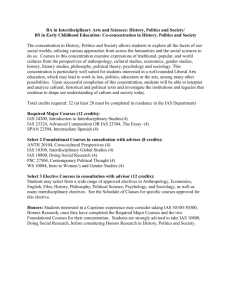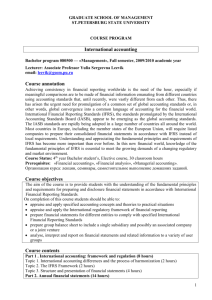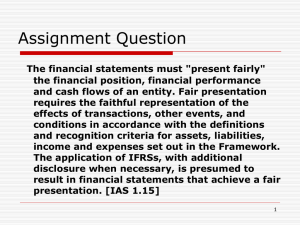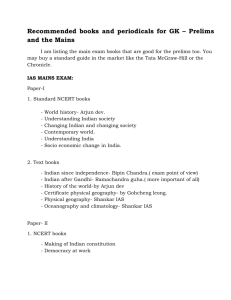Derecognition
advertisement
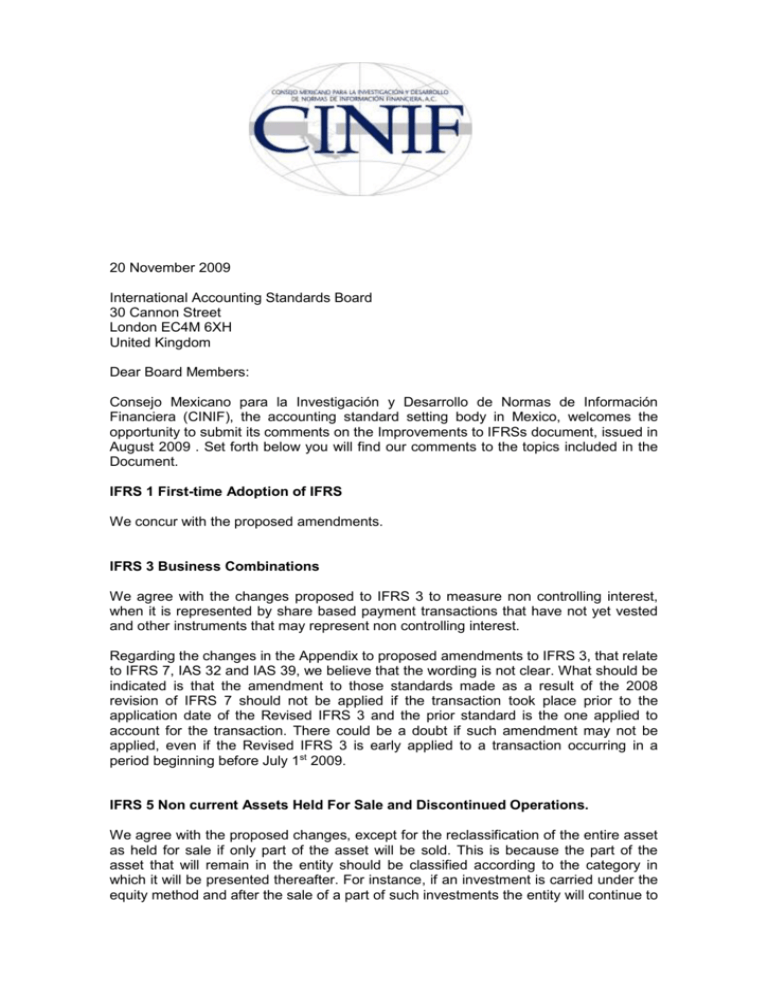
20 November 2009 International Accounting Standards Board 30 Cannon Street London EC4M 6XH United Kingdom Dear Board Members: Consejo Mexicano para la Investigación y Desarrollo de Normas de Información Financiera (CINIF), the accounting standard setting body in Mexico, welcomes the opportunity to submit its comments on the Improvements to IFRSs document, issued in August 2009 . Set forth below you will find our comments to the topics included in the Document. IFRS 1 First-time Adoption of IFRS We concur with the proposed amendments. IFRS 3 Business Combinations We agree with the changes proposed to IFRS 3 to measure non controlling interest, when it is represented by share based payment transactions that have not yet vested and other instruments that may represent non controlling interest. Regarding the changes in the Appendix to proposed amendments to IFRS 3, that relate to IFRS 7, IAS 32 and IAS 39, we believe that the wording is not clear. What should be indicated is that the amendment to those standards made as a result of the 2008 revision of IFRS 7 should not be applied if the transaction took place prior to the application date of the Revised IFRS 3 and the prior standard is the one applied to account for the transaction. There could be a doubt if such amendment may not be applied, even if the Revised IFRS 3 is early applied to a transaction occurring in a period beginning before July 1st 2009. IFRS 5 Non current Assets Held For Sale and Discontinued Operations. We agree with the proposed changes, except for the reclassification of the entire asset as held for sale if only part of the asset will be sold. This is because the part of the asset that will remain in the entity should be classified according to the category in which it will be presented thereafter. For instance, if an investment is carried under the equity method and after the sale of a part of such investments the entity will continue to have significant influence, such part of the investment should continue to be classified as investment in associates. If not, it should be classified as required by IAS 39. The Exposure Draft indicates that the amendment should be applied prospectively. However we believe that if the investment is reclassified, it should be also reclassified in prior years, as it happens with discontinued operations. This is clearly prescribed in IAS 1, p.39. We noticed a typing error at the end of paragraph BC2. It says “...control will be obtained...” when it should say “…control will be maintained“. Also it is not control, but rather joint control or significant influence. IFRS 7 Financial Instruments Disclosures We agree with the changes to IFRS 7 regarding disclosures about the nature and extent of risks arising from financial instruments. We do not agree, however, to delete paragraph 36 (d), since we believe it is important to disclose the amounts of financial assets that would otherwise be past due or impaired and whose terms have been renegotiated. We suggest to modify this paragraph, indicating that this disclosure should be limited to loans renegotiated during a recent period, for instance the last year and that if a loan is not delinquent again, no disclosure would be needed. IAS 1 Presentation of Financial Statements We are in agreement with the proposed amendments to IAS 1. IAS 8 Accounting Policies, Changes in Accounting Estimates and Errors We concur with the proposed changes. IAS 27 Consolidated and Separate Financial Statements We do not agree in accounting for the investment in subsidiaries, associates and joint ventures neither at cost nor at fair value in the separate financial statements of the parent entity. We believe that cost is irrelevant and fair value is not the proper measure, since these investments are not held for sale. As these are permanent investments made to obtain the future benefits that may derive from them, we believe that the only valid measure in the separate financial statements is to measure them under the equity method. If this method is followed the equity presented in the separate financial statements will be the same that the one presented in the consolidated financial statements. We do not see any reason why the equity should differ between the separate and consolidated financial statements, just because investments are valued on a different basis. Presenting investments that are consolidated in the separate financial statements at fair value could be seen as a presumption that these are available for sale, which is not the case. Otherwise, the basis for consolidation could be questioned since the control or significant influence is not permanent. Also, if the amendment to IAS 27 recognizes that a measurement at fair value is valid, what better fair value measurement for a consolidated entity than the one based on the equity method. This is the value at which the net assets of the subsidiary are presented 2 in the consolidated financial statements, which are the ones that reflect the economics of the entity, while the separate financial statements are generally prepared to comply with legal or statutory requirements. Likewise this is the best way to determine a fair value for associates and joint ventures. Trying to determine another value and labeling it as fair value is like trying to determine a value in the market, thus for sale, which would contradict the use of the equity method or the proportional consolidation in the financial statements that purport to present the economics of the whole entity. If there is going to be a change, it should be to a sound basis of financial reporting. IAS 28 Investments in Associates The proposed change included in paragraph 1A indicates that if an entity has an investment in an associate and has significant influence, it should account for it using the equity method. The proposed change goes forward and indicates that if a portion of the investment qualifies for the scope exclusion of paragraph 1, that part of the investment is to be accounted for at fair value. We find this change very confusing, since what happens is that the entity does not have a direct investment in such part of the associate, but in a venture capital organization or a mutual fund, unit trust and similar entities, which in turn have the investment in the part of the associate for which fair value rather than equity method is used. This is correct, since for the venture capital organization or mutual fund, unit trust and similar entities, the investment is held for trading or for sale. However the question that has to be raised is if significant influence is achieved only by adding both the direct and indirect investment. If so, we believe it would be improper to use the part held indirectly, unless the entities holding the indirect investment are controlled (therefore consolidated). If there are not controlled, the management of the venture capital organization or other entities might decide at any moment to sell, and it would be difficult to support that the entity has the ability to maintain significant influence, in which case all the investment should be valued at fair value. We believe this issue should be addressed before or it should be indicated that the indirect investment that allows significant influence is under control, before determining that the equity method of accounting is proper for the direct investment. IAS 34 Interim Financial Reporting We agree with the changes proposed to IAS 34. However, we do have a concern regarding the change to paragraph15B (h), which indicates that interim financial information should disclose the “…significant changes in the business or economic environment that affect the fair value of financial assets and financial liabilities, notwithstanding whether these assets or liabilities are recognized at fair value or amortised cost;”. This may be valid for a short term, since the changes to IFRS 7, Financial Instruments: Disclosures, arising from the issuance of IFRS 9, Financial Instruments, do not indicate that fair value of financial assets carried at amortized cost should be disclosed, except in the case of assets that were reclassified into the amortized cost category since the last annual reporting date. We believe that if significant changes are disclosed, these should apply only to financial assets and liabilities carried al fair value. For the assets carried at amortized cost, what should be disclosed is the effect of significant changes that may affect the impairment of the financial assets or change in value of liabilities carried at amortized cost that have a fixed interest rate. We believe that trying to determine the change in 3 fair value of assets or liabilities carried at amortized cost will create an excessive burden on the entities. IAS 40 Investment Property We agree with the changes proposed. We would like to point out a mistake in paragraph 60, which states that the deemed cost for inventories could be its fair value, when IAS 2 indicates in its paragraph 9 that: “Inventories should be measured at the lower of cost and net realizable value”. We understand that certain inventories can be carried at net realizable value, which does not represent fair value. Indicating in paragraph 60 that inventories can be carried at fair value may mislead some readers who may believe that inventories can be revalued. Therefore we suggest that the reference to inventories and to IAS 2 in paragraph 60 be deleted. Also, we have a doubt regarding if a transfer between categories should be considered as a reclassification. In such case, we believe that even if the application of the amendment is prospective, if the transfer is equal to a reclassification, it should be applied retrospectively according to IAS 1. IFRIC 13 Customer Loyalty Programs We agree with the proposed change. However we question the example, since if the number of points increases, the deferred revenue at the end of year 2 should also be higher. We suggest to review the example. -------------------------------Should you require additional information on our comments listed above, please contact Juan M. Gras at (52) 55 5596 5633 ext 105 or me at (52) 55-5596 5633 ext 103 or by e-mail at jgras@cinif.org.mx or fperezcervantes@cinif.org.mx Sincerely, C.P.C. Felipe Perez Cervantes President of Consejo Mexicano para la Investigacion y Desarrollo de Normas de Informacion Financiera (CINIF) (The Mexican Financial Reporting Standard Board – MFRSB) 4





